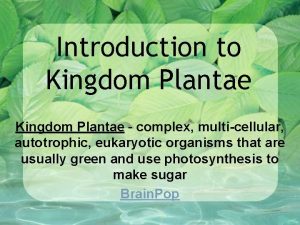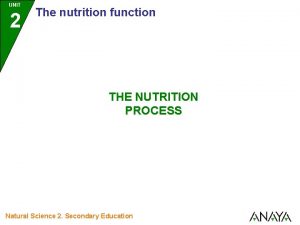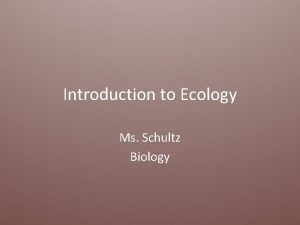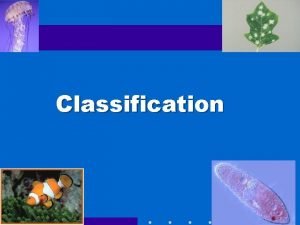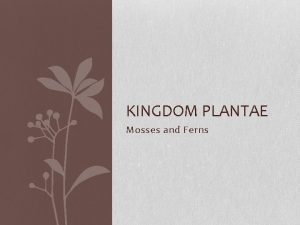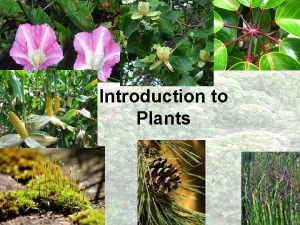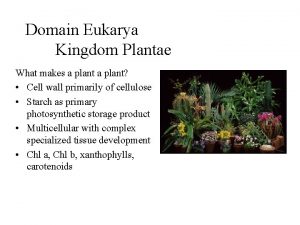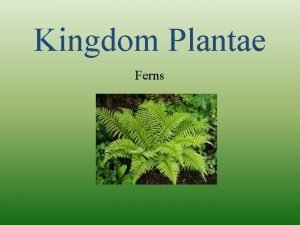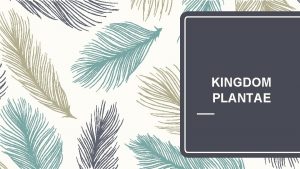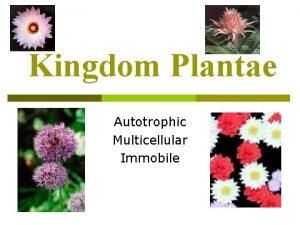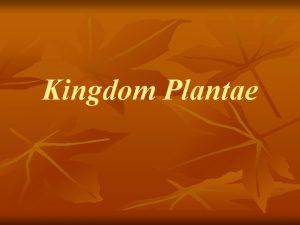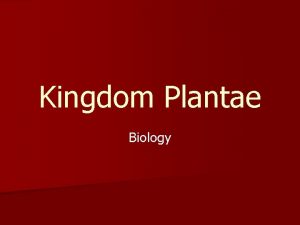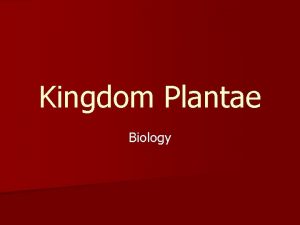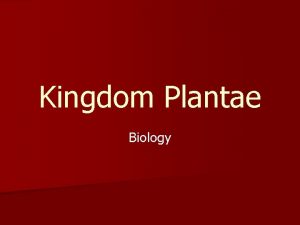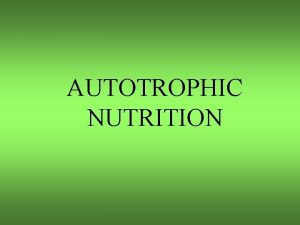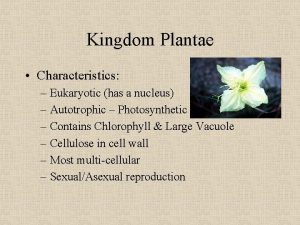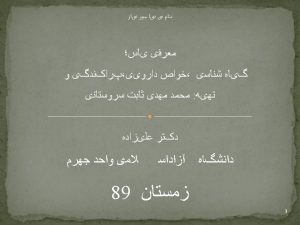PLANTAE KINGDOM NOTES part 6 Plants are autotrophic




















- Slides: 20

PLANTAE KINGDOM NOTES part 6


• Plants are autotrophic (produce their own food), multi-cellular, eukaryotes • Plants store food in the form of starch • Plants cells are surrounded by a cell wall which is made of cellulose

• Plants possess growing regions of activity dividing cells called meristems found at the tips of stems and roots • Auxins are a class of hormone that regulate the growth of plant cells • The phases of a plant life are the sporophyte (2 n) and gametophyte (1 n) stages • Some plants reproduce asexually by a process called vegetative propagation

Leaves are the primary site of photosynthesis • Transpiration is the process in which water and carbon dioxide are lost in leaves through the stomata which are regulated by guard cells • The broad , flat portion of the leaf is the blade which is attached to the stem by a petiole


Compound simple doublecompound

• Taxonomist classify the major groups of plants into DIVISIONS based on whether or not they have vascular tissue

• Nonvascular plants have no true roots, stems, or leaves • Ex: mosses, liverwort

• Vascular plants transport water & mineral from one plant part to another –Seedless plants –Seed plants

• Gymnosperms (naked seed plants) ex: conifers, combs

• Angiosperms (flowering plants) ex: fruit

• Monocots (flowering plants with only one seed leaf) • Dicots (flowering plants with two seed leaves)

Vascular Tissue (transportation) • Xylem – carries water and minerals from the roots to stem • Phloem – transports sugar from leaves to the rest of the plant

Ground Tissue –Parenchyma – storage and food production –Collenchyma – allows cell to grow –Sclerenchyma – provides support and strength of plants • Dermal Tissue – forms the outside coverings of plants

Trophisms • plant movement toward or away from an environmental stimulus. • 5 Types: (away=negative, toward=positive)

• Phototropism –response to light coming from one direction • Hydrotropism – roots respond to water • Gravitotropism – response to gravity • Thigmotropism - growth response to contact with solid object • Chemotropism – plant growth to a chemical

• A flower has two major reproductive structures (SEXUAL reproduction)

• The female reproductive organ or pistil (stigma + style) • The male reproductive organ or stamen (anther + filament) • Pollination is the transfer of pollen from the anther to the stigma

 Insidan region jh
Insidan region jh Similarities between protists and fungi
Similarities between protists and fungi Plantae kingdom drawing
Plantae kingdom drawing Eukarya fungi
Eukarya fungi Old kingdom middle kingdom new kingdom
Old kingdom middle kingdom new kingdom Old kingdom middle kingdom new kingdom
Old kingdom middle kingdom new kingdom Youtube
Youtube Old kingdom middle kingdom new kingdom
Old kingdom middle kingdom new kingdom Which kingdom is autotrophic
Which kingdom is autotrophic Process of nutrients
Process of nutrients Community picture biology
Community picture biology Autotrophic plants examples with names
Autotrophic plants examples with names Phylogenetic tree grade 11
Phylogenetic tree grade 11 Disadvantages of fern plant
Disadvantages of fern plant Main characteristics of plantae
Main characteristics of plantae Plantae kingdom
Plantae kingdom Archegonia domain
Archegonia domain Monera protista fungi plantae animalia
Monera protista fungi plantae animalia Characteristics of organisms in kingdom plantae
Characteristics of organisms in kingdom plantae Protista characteristics chart
Protista characteristics chart Kingdom protista prokaryotic or eukaryotic
Kingdom protista prokaryotic or eukaryotic








